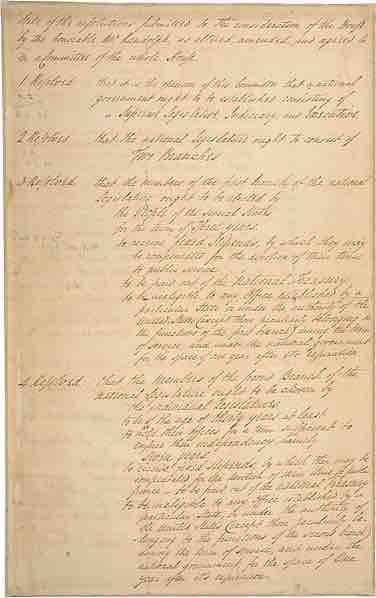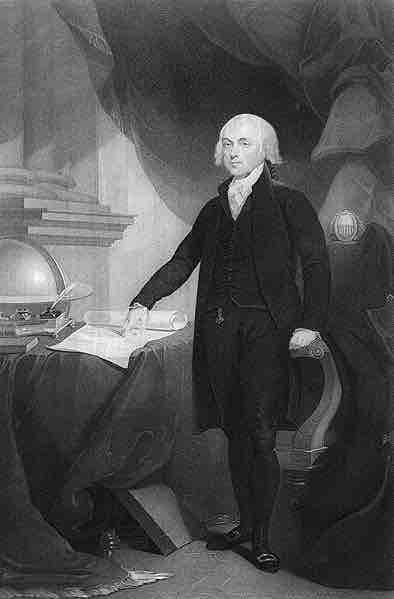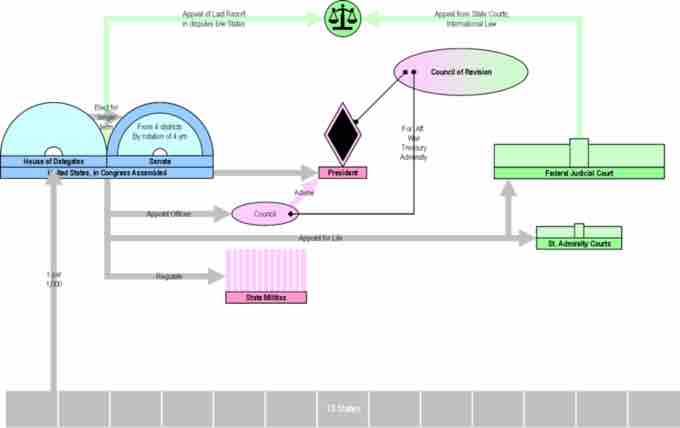Introduction
At the Constitutional Convention, several plans were introduced. Debate topics included the composition of the Senate, how "proportional representation" was to be defined, whether the executive branch would be composed of one person or three, presidential term lengths and method of election, impeachable offenses, a fugitive slave clause, whether to abolish slave trade, and whether judges should be chosen by the legislature or executive.
The Virginia Plan
While waiting for the Convention to formally begin, James Madison sketched out his initial draft, which became known as the Virginia Plan. It also reflected his views as a strong nationalist . The Virginia Plan was a proposal by Virginia delegates for a bicameral legislative branch . Prior to the start of the Convention, the Virginian delegates met and, drawing largely from Madison's suggestions, drafted a plan. The Virginia Plan proposed a legislative branch consisting of two chambers. Rotation in office and recall were two principles applied to the lower house of the national legislature. Each of the states would be represented in proportion to their "Quotas of contribution, or to the number of free inhabitants." States with a large population, like Virginia, would thus have more representatives than smaller states.

The Virginia Plan
The front page of the Virginia Plan document.

Portrait of James Madison
Stippling engraving of James Madison, President of the United States, done between 1809 and 1817.
The Plan of Charles Pinckney
Immediately after Randolph finished laying out the Virginia Plan, Charles Pinckney of South Carolina presented his own plan to the Convention . As Pinckney did not reduce it to writing, the only evidence we have are Madison's notes, so the details are somewhat scarce. It was a confederation, or treaty, among the thirteen states. There was to be a bicameral legislature made up of a Senate and a House of Delegates. The House would have one member for every one thousand inhabitants. The House would elect Senators who would serve by rotation for four years and represent one of four regions. Congress would meet in a joint session to elect a President, and it would also appoint members of the cabinet. Congress, in joint session, would serve as the court of appeal of last resort in disputes between states. Pinckney did also provide for a supreme Federal Judicial Court. The Pinckney plan was not debated, but it may have been referred to by the Committee of Detail for early draft.

Pinckney Plan
The Pinckney Plan proposed a bicameral legislature made up of a Senate and a House of Delegates. The House would have one member for every one thousand inhabitants. The House would elect Senators who would serve by rotation for four years and represent one of four regions. Congress would meet in a joint session to elect a President, and would also appoint members of the cabinet. Congress, in joint session, would serve as the court of appeal of last resort in disputes between states.
New Jersey Plan
After the Virginia Plan was introduced, New Jersey delegate William Paterson asked for an adjournment to contemplate the plan. Under the Articles of Confederation, each state had equal representation in Congress—one vote per state. Paterson's New Jersey Plan was ultimately a rebuttal to the Virginia Plan. Under the New Jersey Plan, the unicameral legislature with one vote per state was inherited from the Articles of Confederation. This position reflected the belief that the states were independent entities that could enter and leave the United States on their own volition.
Hamilton's Plan
Unsatisfied with the New Jersey Plan and the Virginia Plan, Alexander Hamilton proposed his own plan. It also was known as the British Plan, because of its resemblance to the British system of strong centralized government. Hamilton's plan advocated doing away with much state sovereignty and consolidating the states into a single nation. The plan featured a bicameral legislature, the lower house elected by the people for three years. The upper house would be elected by electors chosen by the people and would serve for life. The plan also gave the Governor, an executive elected by electors for a life-term of service, an absolute veto over bills. State governors would be appointed by the national legislature, and the national legislature had veto power over any state legislation.
Hamilton presented his plan to the Convention on June 18, 1787. The plan was perceived as a well-thought-out plan, but it was not considered because it resembled the British system too closely.
Connecticut Compromise
To resolve this stalemate, Roger Sherman, a delegate from Connecticut, forged the Connecticut Compromise. In a sense it blended the Virginia (large-state) and New Jersey (small-state) proposals. Ultimately, its main contribution was determining the method for apportionment of the Senate and retaining a federal character in the constitution.
What was ultimately included in the Constitution was a modified form of this plan. In the Committee of Detail, Benjamin Franklin added the requirement that revenue bills originate in the House. As such, the Senate would bring a federal character to the government, not because senators were elected by state legislatures, but because each state was equally represented.